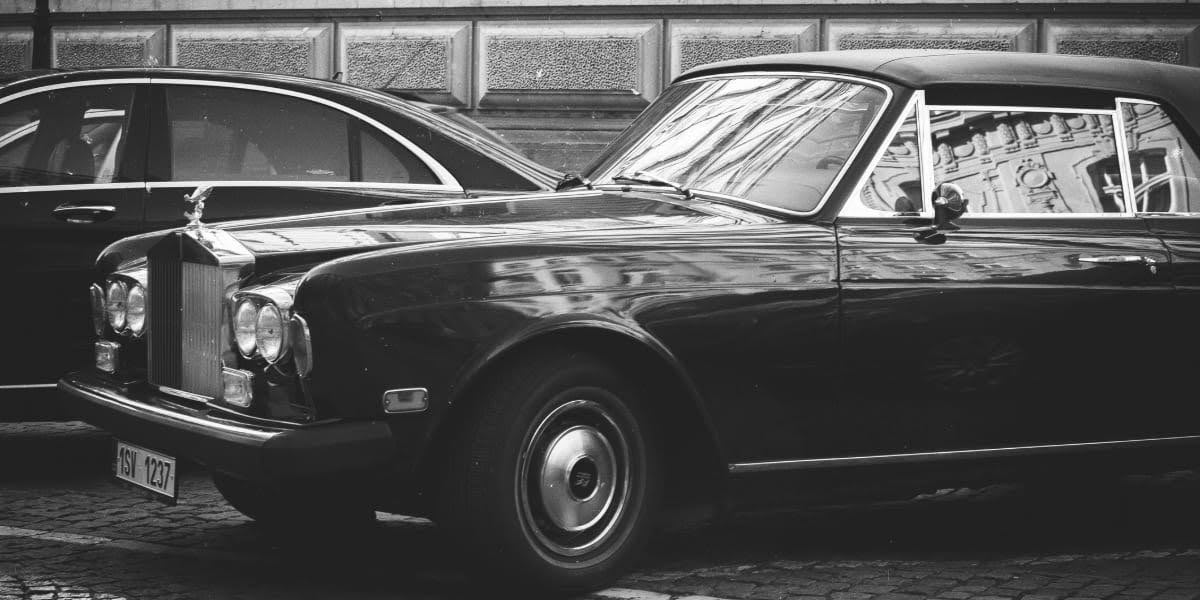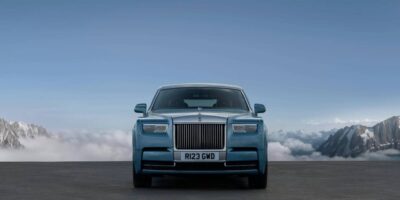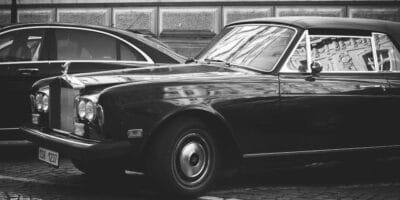The Rolls Royce Camargue isn’t your typical classic car. When it came out in the 1970s, it looked different, and felt different, from what people expected from Rolls Royce. And while it didn’t get a ton of love back then, today it’s starting to turn heads for all the right reasons.
Let’s take a closer look at why the Camargue broke so many rules, how it connects to the famous 1970 Rolls Royce era, and why collectors are finally starting to give it the spotlight it deserves.
A Bold Move in Rolls Royce History
When people think of Rolls Royce, the image that comes to mind is often the same: a big, formal car gliding down the road, polished to perfection, with a suited chauffeur behind the wheel. These cars are usually tall, elegant, and shaped like they were built for royalty—which, honestly, many of them were.
But then something surprising happened. In 1975, Rolls Royce introduced a model that didn’t look—or feel—like anything they’d done before. It was called the Rolls Royce Camargue, and from the start, it was clear this car was going to break the rules.
What made the Camargue so different?
Unlike every Rolls Royce before it, the Camargue wasn’t designed by the company’s own styling team. Instead, they took a big leap and asked Paolo Martin, a designer at the famous Italian design house Pininfarina, to lead the styling.
This was a major first for Rolls Royce. They had never handed over design responsibilities to someone outside the company. And what they got back was unlike anything in their lineup.
Here’s what made the Camargue stand out:
- Low and wide body: Instead of being tall and boxy, the Camargue had a flat roof and a wide stance, giving it a more modern, sporty look.
- Smooth, clean lines: It didn’t have the upright grille or sharp angles most people expected from Rolls Royce. It was sleek and understated.
- Two-door coupe: Most Rolls Royce models at the time were four-door sedans. The Camargue was built as a luxurious grand touring coupe.
- Hidden luxury: It wasn’t flashy or loud. It looked simple on the outside, but inside, it was just as luxurious as you’d expect—with leather seats, wood trim, and top-of-the-line technology for the time.
For some, this change was exciting. For others, it was too big of a shift.
Why did Rolls Royce make such a bold move?
At the time, the car world was changing. The 1970s brought in new trends, new technologies, and a new generation of drivers who wanted something fresh. Rolls Royce realized they couldn’t just keep making the same style of car forever.
So, the Camargue was their answer to that. It was their way of saying, “We’re not afraid to try something different.”
And while it didn’t fit the traditional image of a Rolls Royce, the company believed it was time to evolve. They wanted to keep the luxury, but give it a new shape—one that matched the style of the future.
How was the Camargue received when it came out?
Let’s be honest: not everyone loved it right away.
- Some praised it for being bold and ahead of its time.
- Others criticized it for not looking “Rolls Royce enough.”
One of the biggest shocks? The price. When it was released, the Camargue was the most expensive production car in the world. It cost almost twice as much as the popular Rolls Royce Silver Shadow. That price tag alone made some people question if the car was worth it—especially because it looked so different.
Sales were modest. Rolls Royce didn’t sell thousands of these. In fact, they made just 531 Camargues between 1975 and 1986. That’s extremely rare by any standard.
Why didn’t it sell like other Rolls Royce models?
There were a few reasons:
- It looked too different from what buyers were used to.
- It was too expensive for some, even those who could afford other Rolls Royce models.
- It came out during a tricky time, when the global economy was facing challenges like oil crises and inflation.
So while the Camargue was advanced and stylish, it didn’t quite connect with the public the way Rolls Royce had hoped.
Was the Camargue a failure?
Not at all—it just took time for people to see its value.
Even though it wasn’t a best-seller, the Rolls Royce Camargue was an important part of the company’s history. It showed that Rolls Royce was willing to take creative risks and step outside of their comfort zone. And now, years later, that bold move is finally being appreciated.
In fact, more and more collectors today are going back and saying:
“You know what? The Camargue was actually ahead of its time.”
What makes the Camargue special today?
Now that decades have passed, people are starting to see the Camargue with fresh eyes. Today, it’s admired for the very things that made it controversial in the first place.
- It’s rare – With only 531 ever built, it’s one of the lowest-production Rolls Royce models.
- It has a cool backstory – An Italian-designed British luxury car? That’s something unique.
- It broke the mold – It dared to be different at a time when most brands were playing it safe.
Bottom Line
The Rolls Royce Camargue didn’t follow the rules—and that’s exactly what makes it special. While some may have questioned it in the 1970s, it’s now clear that this bold design choice deserves a spot in the spotlight. For collectors who want something rare, stylish, and rich in history, the Camargue is finally getting the recognition it always deserved.
Let me know if you’d like the next section expanded too—happy to keep going!
Looking Back at the 1970 Rolls Royce Era
If you really want to understand what made the Rolls Royce Camargue special, you need to look at the era it came from. The 1970 Rolls Royce lineup was a turning point for the brand—a time when Rolls Royce started modernizing its cars and taking risks that would shape its future.
The Camargue didn’t just appear out of nowhere. It was built on the foundation that Rolls Royce had already laid in the early 1970s. Models like the Silver Shadow and Corniche set the stage, and the Camargue took those ideas even further.
What Was Happening with Rolls Royce in the 1970s?
During the 1970s, Rolls Royce started changing the way they designed and built their cars. While they still focused on craftsmanship and luxury, they were also beginning to introduce more modern features and engineering upgrades.
Some key changes in the 1970 Rolls Royce era included:
- Hydropneumatic suspension: A self-leveling suspension system that made the ride smoother and more controlled, no matter the road conditions.
- Disc brakes: Better stopping power, which made driving safer and more responsive.
- Unitized body construction: Moving away from the old-fashioned body-on-frame style to a more modern, solid body design.
- Updated engines and transmissions: More power, more torque, and smoother gear shifts.
These changes may sound normal today, but at the time, they were big improvements for luxury cars.
Q: What made the Silver Shadow so important?
The Silver Shadow was introduced in the mid-1960s and was still a major player in the 1970s. It became the best-selling Rolls Royce ever—and for good reason. It was the first model to feature:
- Hydropneumatic suspension
- Four-wheel disc brakes
- A more compact body, making it easier to drive in cities
The Silver Shadow proved that you could still have a classic Rolls Royce feel while enjoying the benefits of modern technology. This balance between tradition and progress is something the Rolls Royce Camargue would carry forward.
Q: How did the Corniche influence the Camargue?
The Corniche was another important model during the 1970 Rolls Royce era. It was a more stylish, sporty version of the Silver Shadow, available as a two-door coupe or convertible.
The Corniche showed that luxury cars didn’t always have to be large sedans—they could be elegant, performance-minded vehicles for personal driving. This idea helped pave the way for the Camargue, which was also a two-door grand touring coupe with an emphasis on personal style and a smooth, powerful ride.
The Camargue’s Connection to the 1970 Rolls Royce Lineup
Although the Rolls Royce Camargue looked very different from the Silver Shadow or the Corniche, it actually shared a lot under the surface. It used the same platform as the Silver Shadow, meaning the basic structure and engineering were familiar and proven.
Here’s what the Camargue inherited from the 1970s models:
- 6.75-liter V8 engine: This engine was powerful, smooth, and already trusted by Rolls Royce drivers. It provided plenty of torque and a quiet, effortless ride.
- Hydropneumatic suspension: Just like the Silver Shadow, the Camargue floated over bumps and rough roads with ease.
- Advanced braking and steering systems: Improved driver control and safety.
Even though it had a fresh new design, the Camargue wasn’t starting from scratch. It was built on the strong, reliable foundation of the 1970 Rolls Royce engineering—but added its own twist.
A New Feature That Made Headlines: Dual-Level Climate Control
One of the Camargue’s standout features was its automatic climate control system. But this wasn’t just any climate system—it was the world’s first split-level A/C system, meaning it could control the temperature separately for the upper and lower parts of the cabin.
Why this was a big deal:
- Most cars at the time only had basic heating and cooling
- This system allowed for better comfort during long drives
- It showed Rolls Royce’s focus on passenger experience and innovation
This kind of feature proved that the Camargue wasn’t just about looks—it was designed to improve the driving experience in real, noticeable ways.
So, Was the Camargue Really a Part of the 1970 Rolls Royce Family?
Yes—absolutely. While the Camargue’s design made it look like a completely different car, its heart and soul came from the 1970s lineup. It carried over the proven tech, engine, and ride quality that people already loved in the Silver Shadow and Corniche.
What made it stand out was how it combined those solid bones with bold, Italian-inspired design and never-before-seen features. That combination helped the Camargue bridge the gap between classic Rolls Royce luxury and forward-thinking design.
The Rolls Royce Camargue may have looked like a big leap forward, but it was built on the trusted foundation of the 1970 Rolls Royce era. It took everything the brand had learned up to that point—luxury engineering, smooth performance, comfort—and packaged it in a fresh, daring new body.
Looking back now, it’s clear the Camargue wasn’t just a departure from tradition. It was an evolution—one that connected the elegance of the past with the possibilities of the future.
Let me know if you’d like the next section expanded as well!
Why Collectors Are Starting to Love the Camargue
When the Rolls Royce Camargue first came out, people didn’t really know what to make of it. It looked different. It didn’t follow the typical Rolls Royce design. And it certainly didn’t act like a car trying to fit in. But now, that’s exactly why collectors are finally starting to appreciate it.
Today’s car collectors aren’t just looking for beauty or speed—they want something with a story. They’re drawn to vehicles that are unique, rare, and have a bit of mystery behind them. The Camargue checks all those boxes—and more.
Let’s break down why this once-overlooked coupe is now becoming a favorite among serious collectors.
1. It’s Super Rare
Q: How rare is the Rolls Royce Camargue?
Only 531 units were ever made between 1975 and 1986, and they weren’t mass-produced or widely exported. That makes the Camargue one of the rarest Rolls Royce models ever.
For collectors, that kind of scarcity matters a lot. When only a few hundred were made—and even fewer are still in great condition today—it becomes something worth hunting for. Rarity creates value, especially when the car also has a unique design and backstory.
Why rarity matters to collectors:
- Fewer cars mean higher exclusivity
- Hard-to-find models create more buzz at auctions and shows
- Owning one means being part of a small, elite group
In short, if you pull up in a Camargue at a car event, chances are you’ll be the only one.
2. It Stands Out from the Crowd
Q: Why does the Camargue look so different from other Rolls Royce models?
The Camargue was designed by Paolo Martin from Pininfarina, an Italian design house better known for working with Ferrari. That alone gave it a look that broke away from the traditional Rolls Royce style. Instead of the usual upright body and massive grille, the Camargue featured:
- A low, wide profile
- Smooth, aerodynamic lines
- A subtle grille that didn’t scream for attention
- A two-door coupe shape meant for grand touring
The result? A car that looked like a mix between British luxury and Italian flair.
This bold design was part of what confused people when it first launched, but today it’s what makes it cool. Collectors love cars that don’t blend in—and the Camargue definitely doesn’t.
Why standing out is a good thing:
- It shows confidence and character
- It reflects a bold moment in Rolls Royce history
- It offers something different in a sea of classic cars
If you’re tired of seeing the same vintage models everywhere, the Rolls Royce Camargue offers a refreshing change.
3. It’s a One-of-a-Kind Collaboration
Q: Has Rolls Royce ever worked with outside designers before?
Before the Camargue, the answer was no. Rolls Royce had always designed their cars in-house. The Camargue was the first time they handed the design over to someone else—an Italian team, no less.
That makes the Camargue even more special. It’s not just a Rolls Royce—it’s a fusion of two worlds:
- British craftsmanship and mechanical engineering
- Italian artistry and bold design
This collaboration wasn’t just rare for Rolls Royce—it was rare for the entire luxury car industry at the time. It helped pave the way for more global, creative partnerships in the years to come.
What makes this partnership special:
- It introduced a fresh design language to a traditional brand
- It blended two luxury cultures—British and Italian
- It proved Rolls Royce was willing to take creative risks
For collectors who care about automotive history, the Camargue tells an important story about stepping out of a comfort zone.
4. The Value Is Going Up
Q: Is the Camargue a good investment?
Until recently, the Camargue was surprisingly affordable—at least compared to other vintage Rolls Royce models. That’s because for many years, it flew under the radar. It wasn’t seen as “classic enough” by traditional collectors, so prices stayed low.
But that’s changing.
Over the past few years, more collectors and car experts have started to talk about the Camargue as an underappreciated gem. As interest grows, so do the prices.
What’s causing prices to rise:
- Increased demand from collectors who want something rare and different
- Limited supply due to low production numbers
- Growing recognition in the classic car world
- A rising trend of “hidden gem” cars gaining popularity
If you’re a collector looking for a car that’s still within reach but quickly gaining attention, the Rolls Royce Camargue is worth keeping an eye on. It’s the kind of car that could turn out to be a smart long-term investment—especially if you find one in good condition.
So, why are collectors falling in love with the Rolls Royce Camargue now, decades after its debut?
Because it’s everything today’s collector wants:
- Rare
- Bold
- Different
- Historically significant
- And finally getting the recognition it deserves
At first glance, the Camargue might not look like a typical Rolls Royce. But that’s exactly the point. It broke the rules in the 1970s—and now, collectors are rewarding it for doing just that.
If you’re searching for a classic car that stands apart from the crowd and tells a story of design, innovation, and quiet rebellion, the Camargue might be your next favorite find.
What Makes the Rolls Royce Camargue Special
Even after all these years, the Rolls Royce Camargue still has some amazing features that feel impressive today. Here are a few that really stand out:
- Dual-Level A/C System: It had one of the first climate control systems that could cool or heat different parts of the car separately. That was a big deal in the 1970s.
- Flush Glass Design: The windows and glass were smooth and fit tightly into the body—something you didn’t see much back then.
- Wide, Low Shape: Instead of being tall and upright, the Camargue was low and wide, giving it a sporty but classy look.
- Handmade Interior: Like all Rolls Royce cars, the inside was pure luxury—leather seats, polished wood, thick carpets—every detail was crafted by hand.
The Camargue’s Time to Shine
Back in the day, the Camargue was seen as a bit of an outsider. It wasn’t what people were used to, and that made it hard for some to accept. But today, that outsider status is exactly why collectors want it.
If you’re someone who appreciates rare cars, unique design, and hidden gems in the luxury world, the Camargue is worth a second look. It’s not just a car—it’s a piece of history that shows what can happen when a brand decides to take a risk.
And for Bentley fans, the Camargue represents the same values: timeless craftsmanship, bold ideas, and the kind of luxury that doesn’t follow the crowd—it leads it.
Final Thoughts: Why the Rolls Royce Camargue Is Finally Getting the Love It Deserves
The Rolls Royce Camargue may not have fit in when it first came out, but that’s exactly what makes it special today. It dared to be different, and now collectors are seeing the value in that. From its rare production numbers to its stylish Italian design, the Camargue is finally stepping into the spotlight—and it’s not going anywhere.
Want to explore more rare and iconic vehicles like the Camargue? Contact us today to learn more about our luxury collection and how we can help you find a classic worth collecting.






